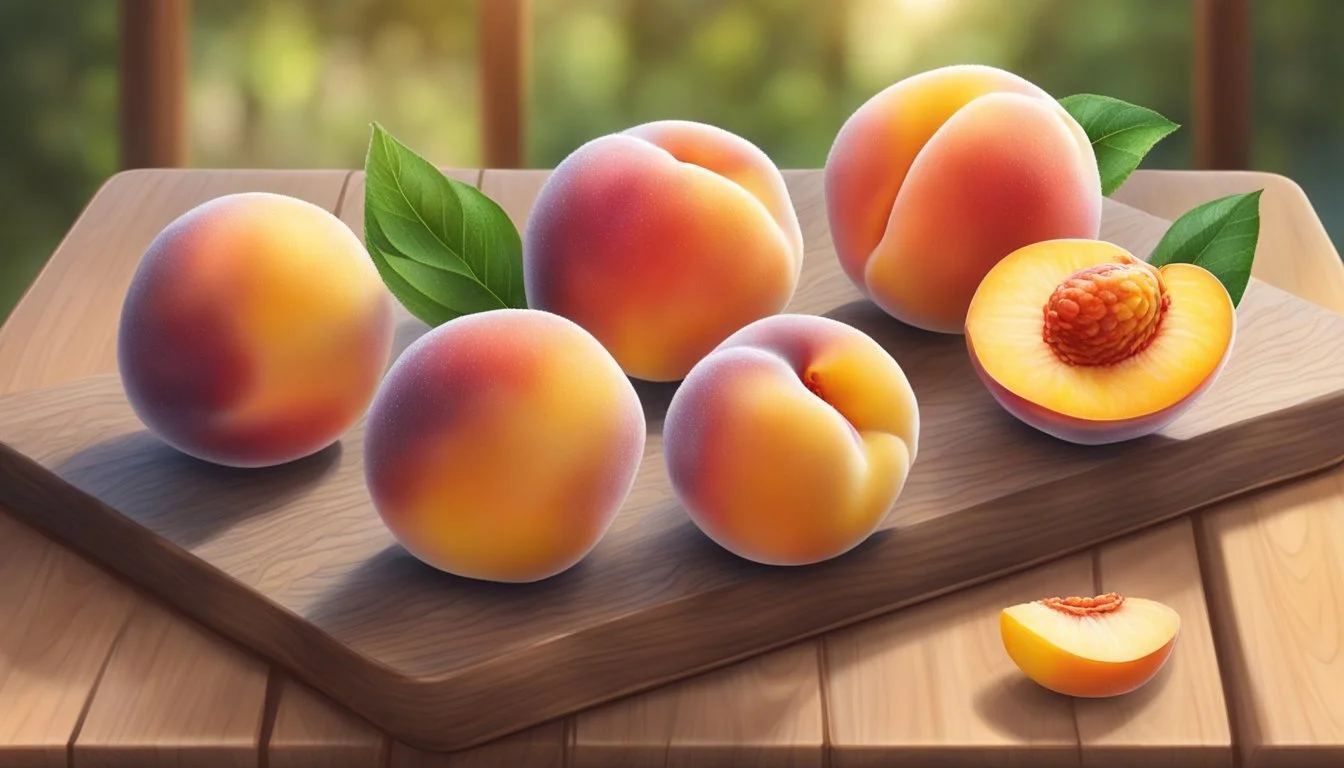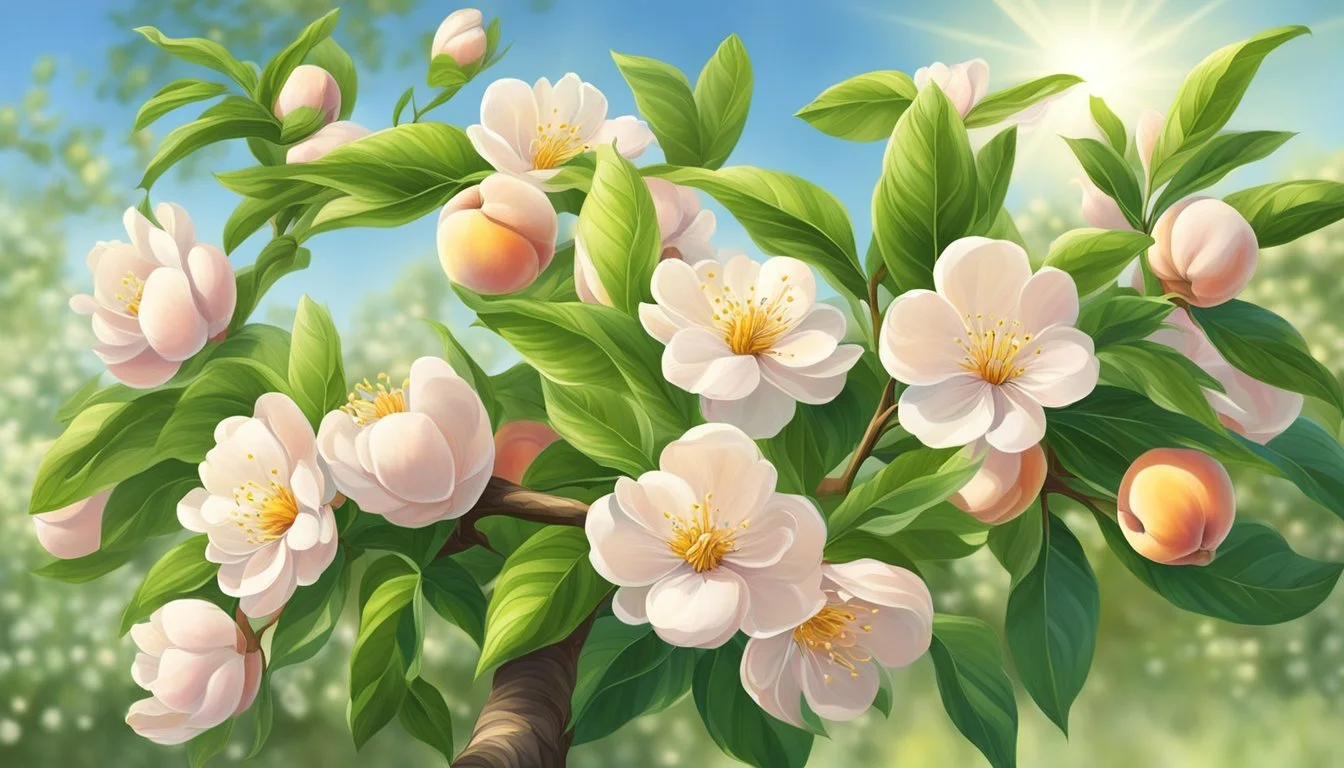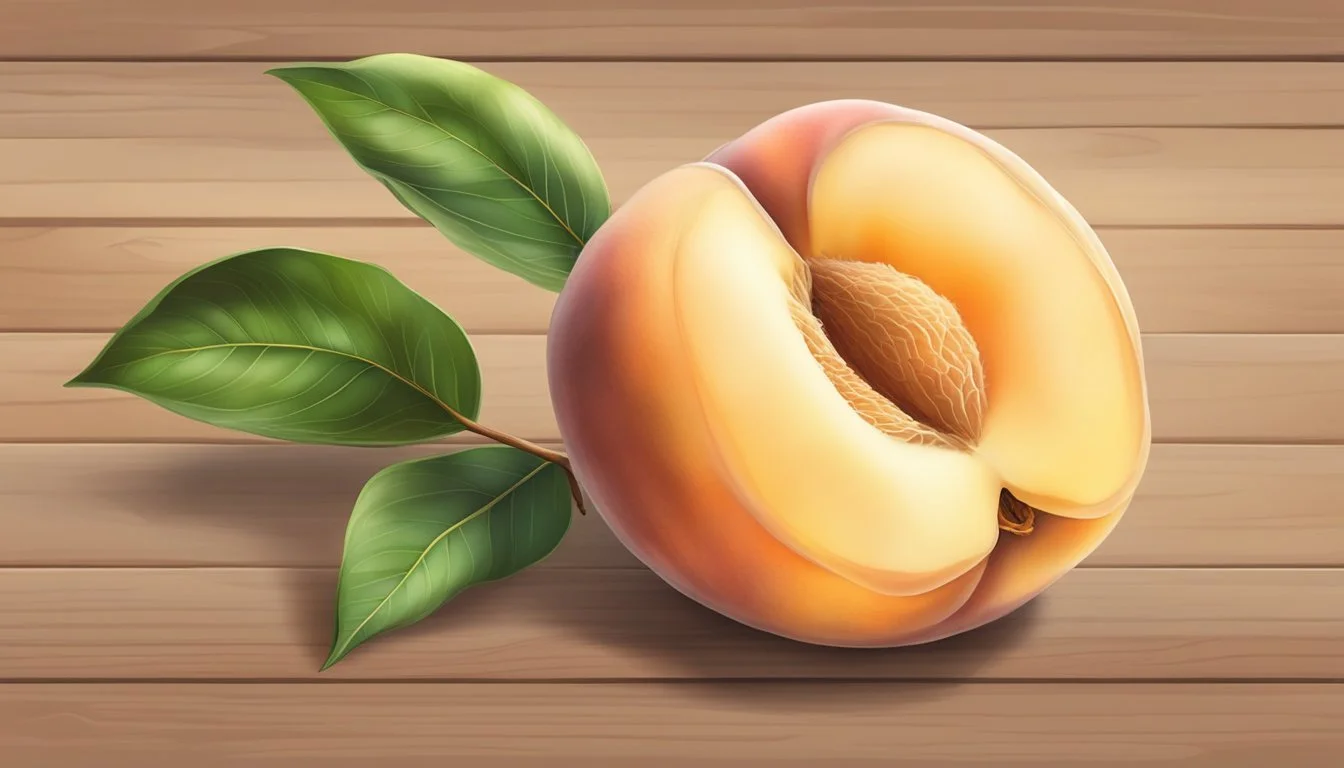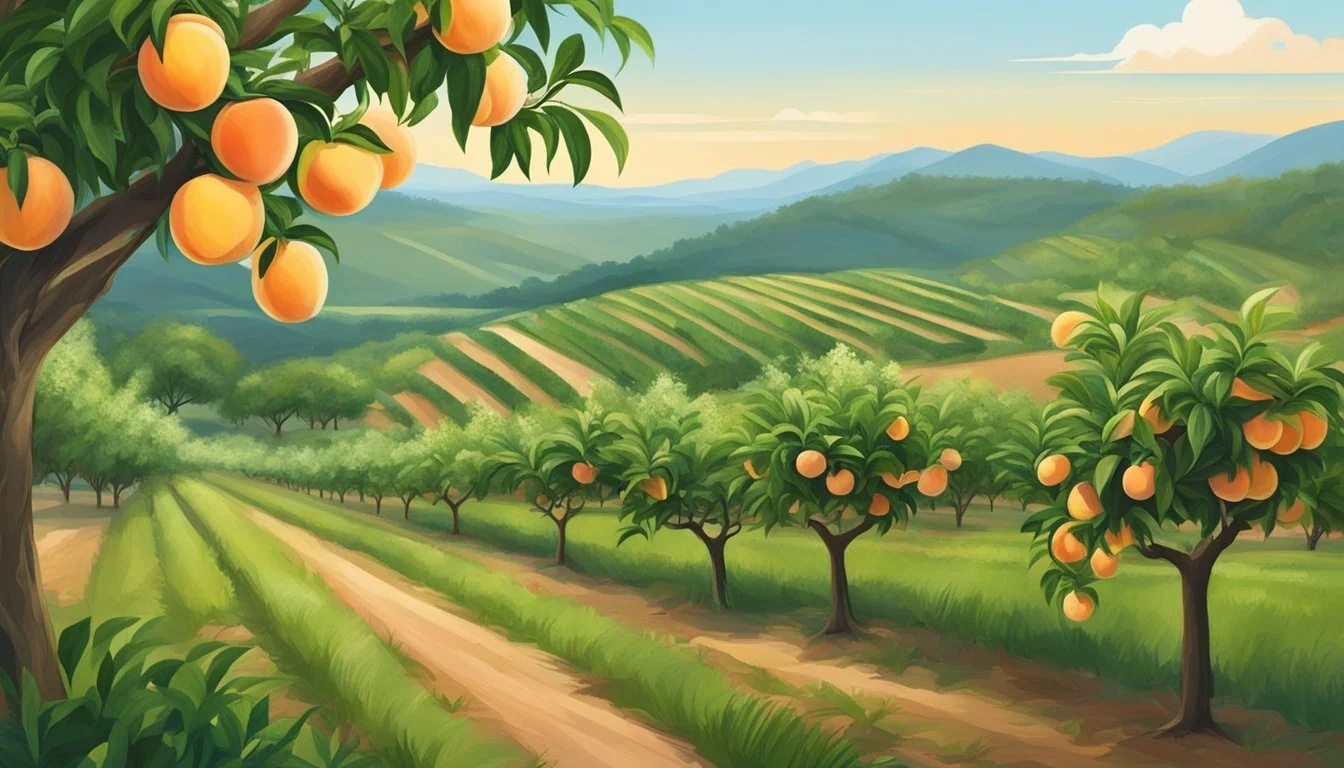How to Tell If White Flesh Peaches Are Ripe
Your Ultimate Ripeness Checklist
White flesh peaches, a variant of Prunus persica, are prized for their delicate flavor and aromatic qualities. These peaches are distinctive not just for the pale hue of their flesh but also for their less acidic taste compared to their yellow-fleshed counterparts. Knowing when a white peach is ripe is crucial for consumers and chefs alike to ensure the best eating experience. Ripe white peaches will exhibit a certain give when gently pressed near the stem and a sweet, floral aroma, indicative of their readiness for consumption.
The peak season for white peaches is typically during the summer months when they are most abundant and can be found at their freshest. As a stone fruit, timing is essential as the window for optimal ripeness is narrow and demands careful attention. For those ripening peaches at home, the process can be expedited by storing them in a paper bag at room temperature. Conversely, refrigeration can help slow down ripening, extending their shelf life once they've reached peak maturity.
Key Takeaways
A ripe white peach has a slight softness near the stem and a fragrant aroma.
White peaches reach peak ripeness in summer, aligning with their harvest season.
Proper storage methods can control the ripening process of white peaches.
Identifying Ripe White Peaches
In selecting white peaches, one should consider various indicators such as color, texture, and scent. It's important to recognize the differences from yellow peaches to ensure the white peaches are at their peak ripeness.
Color and Appearance
A ripe white peach has a creamy, white flesh that may be tinged with pink or red near the skin. One should not expect the deep yellow hue often seen in ripe yellow peaches. Any green tinges around the stem indicate that the peach is not yet ripe. Look for a uniform coloration, without the greenish undertones.
Texture and Firmness
Gently pressing the peach's surface should reveal a slight give, indicating softness yet still firm to the touch. A ripe white peach is not hard, but should not feel overly mushy or yielding to slight pressure. The texture is a vital clue, with a slightly softer feel around the stem being a sign of ripeness.
Scent and Fragrance
A ripe white peach emits a distinctive floral scent that is sweet and fragrant. If one smells the peach by the stem, the fragrance should be stronger and more pronounced, indicative of the fruit's readiness to eat. An absence of scent often suggests that the peach is not yet fully ripe.
Stem and Bruising
Inspecting the stem area of a white peach provides insights into its ripeness. A ripe peach may have a slight wrinkling around the stem which is natural as it ripens. Avoid peaches with excessive bruising, as this can signal overripeness or poor quality. One or two small blemishes may be acceptable, but they should not cover the fruit or impact its overall firmness.
Taste Profile of the Perfect Peach
When selecting a white flesh peach, the taste is a critical factor in determining its perfection. White peaches are distinguished by their low acid content which results in a remarkably sweet flavor. These peaches are typically less acidic than their yellow counterparts, meaning they do not have the tartness that can sometimes overshadow the sweetness of other peach varieties.
The flavor profile of a ripe white peach is subtly enhanced by floral notes, which contribute to a sophisticated, nuanced taste experience. One can expect white peaches to provide a delicate and refreshing flavor that's often described as sweeter and more succulent than other types of peaches.
Here is a breakdown of the taste characteristics:
Sweetness: Natural sugars develop more in white peaches, giving them a higher perceived sweetness.
Flavor Profile: A combination of sweetness balanced with delicate floral undertones.
Acid: Low acid levels result in a less tart and more honeyed taste.
Floral Attributes: Presence of soft floral notes that enhance the overall flavor.
In summation, the taste profile of a perfect white peach is one of gentle sweetness laced with floral undertones. It is the interplay of these elements that produces a truly delightful fruit experience. Shoppers should seek out white peaches that are firm yet yield slightly to pressure, a sign that the fruit has reached its peak in both flavor and texture.
The Role of Season and Harvest in Peach Ripeness
White flesh peaches, like all peach varieties, are seasonal fruits with their ripeness significantly influenced by the time of year and harvest practices. The season typically dictates the natural lifecycle of peach development, with summer being the prime time for these fruits to reach optimum sweetness and texture. Different geographic regions might see slight variations in the ripening calendar, but generally, white flesh peaches come into season in late spring and continue through the summer months.
During the harvest, the time at which peaches are picked is crucial for ensuring proper ripeness. White flesh peaches do not ripen significantly after being harvested, so growers must be precise in their timing. They look for signs like:
Color change: The area of the peach skin not exposed to direct sunlight shifts to a creamy white or pale yellow.
Softness around the stem: The flesh should give slightly under gentle pressure.
Aroma: Ripe peaches emit a sweet, fragrant scent that is easily noticeable.
Harvesting too early means the peaches might be too firm and lack flavor, while waiting too long could result in fruit that is overly soft and potentially bruised. Professional growers often use tools like penetrometers to measure the firmness of the peaches, ensuring consistency in the harvest.
To encapsulate, the ripeness of white flesh peaches is a synergistic result of their seasonal growth patterns and precise harvest methods. Consumers will find the best quality peaches during their peak season in the summer and when harvested with attention to the subtle cues of fruit maturity.
How to Store and Ripen Peaches at Home
Storing and ripening white flesh peaches properly ensures maximum freshness and flavor. Whether one intends to consume them shortly or prefers to keep them for an extended period, understanding the right methods for storage and ripening is essential.
Immediate Consumption
For peaches destined for immediate consumption, one should store them at room temperature—away from direct sunlight—to maintain their freshness. If they are ripe and ready to eat, a refrigerator can keep them fresh for a short while. However, they are best enjoyed soon after they've reached the peak of ripeness to capture their full flavor.
Long-Term Storage
When one needs to store peaches for a more extended period, there are a couple of steps to follow:
Refrigeration: Store ripe peaches in the crisper drawer of the refrigerator to prolong freshness. Check them regularly since refrigeration can dehydrate them, leading to wrinkly skin.
Freezing: For very long-term storage, one can freeze peaches. First, cut the peaches into halves or slices, remove the pits, and place them on a baking sheet in the freezer. Once frozen, transfer them to airtight bags or containers to prevent freezer burn.
Speeding Up the Ripening Process
To accelerate the ripening process of white flesh peaches, one can utilize the ethylene gas that fruit naturally emits. Follow these steps:
Place unripe peaches in a paper bag.
Add an apple or banana to the bag, as these fruits increase ethylene concentration.
Seal the bag and keep it at room temperature.
Check the peaches daily until they reach the desired ripeness.
By controlling the environment in which white flesh peaches are stored and ripened, enthusiasts can ensure these delicate fruits are enjoyed at their most flavorful and succulent state.
White Peach Varieties and Selection Tips
Selecting the perfect white peach begins with understanding the different varieties available and the characteristics that signify ripeness. This guide will assist in identifying popular cultivars and outline key criteria for selection.
Popular Varieties
Saturn (Peento): Known for its flattened shape and sweet flavor, this variety is easily recognizable.
Freestone: Varieties like the White Lady fall into this category, which indicates that the flesh does not cling to the pit, making them ideal for fresh eating and ease of preparation. They possess a larger size and a floral scent.
Clingstone: These peaches have flesh that clings tightly to the pit. A common clingstone variety is the Polly White.
White Nectarines: Although technically a different species, these share many characteristics with white peaches, offering a smooth skin and a similar flavor profile.
Selection Criteria
Size and Color:
Look for a full, uniform size and pay attention to the blush of color; a creamy to white hue with possible red blush indicates maturity.
Avoid fruits with green undertones as they may have been picked too early and might not ripen properly.
Firmness:
Ripe peaches will yield slightly under gentle pressure near the stem. They should feel firm but not hard.
Scent:
A sweet and floral aroma is a primary indicator of a ripe white peach. The stronger the scent, the more likely the peach is ripe.
Demand:
Some varieties may be harder to find due to less demand or more challenging cultivation requirements, so availability can vary by region and season.
Nutritional Content and Health Benefits
White flesh peaches are esteemed not only for their sweet flavor but also for their nutritional benefits. They are an excellent source of essential nutrients that are vital for maintaining good health.
Vitamins:
Vitamin C: This antioxidant plays a crucial role in skin health and immune function.
Vitamin A: Important for vision health, immune support, and cell growth.
Minerals:
Potassium: An electrolyte that helps to regulate fluid balance and muscle contractions.
Dietary Fiber: White peaches contribute to daily fiber intake, which aids in digestion and can help to manage weight.
In terms of caloric content, a medium-sized white peach (about 5 ounces) typically contains around 58 calories, making it a low-calorie food option that can fit into a variety of diets.
The combination of these nutrients supports overall health, providing benefits such as an improved immune system, better digestive health, and the potential to reduce the risk of certain chronic diseases. By incorporating white peaches into one's diet, individuals can enjoy not only a delicious fruit but also take advantage of its health-promoting qualities.
Preparing White Peaches for Culinary Use
Proper preparation of white peaches can enhance their sweet and floral profile, making them a versatile ingredient in a wide range of recipes. From fruit salads to baked desserts, knowing how to prep these peaches is key to their best use in the kitchen.
Preparation Techniques
Slicing and Peeling: For most applications, a white peach should be first washed thoroughly. To slice, one should cut around the natural seam, twist the halves, and remove the pit. If peeling is desired, blanching can facilitate the removal of the skin; submerge the peaches in boiling water for 30 seconds and then transfer them to ice water to loosen the skin.
For salads and salsas: Thinly slicing or dicing the peaches can add a sweet, succulent element to the dish.
For pies and cobblers: White peaches should be cut into consistent sizes to ensure even cooking.
Grilled Peaches:
Preheat the grill to medium heat.
Brush sliced peaches with oil to prevent sticking and grill until charred and tender, enhancing their natural sweetness.
Using Peaches in Recipes
Desserts:
Pies and Cobblers: White peaches can be mixed with sugar and spices, then baked into pies or cobblers.
Ice Cream and Jams: Their sweet flavor profile can also be cooked down for use in ice creams or preserved as jams.
Smoothies and Salads:
Chopped peaches make a delicious addition to smoothies, providing a natural sugar boost and creamy texture.
Dice or slice them into salads for a juicy, fragrant bite.
Baking:
When baking with white peaches, they can be incorporated into the batter or used as a flavorful topping.
It’s crucial to adjust the sugar levels in recipes, as the sweetness of white peaches can vary.
Cooking: White peaches add a delightful twist to savory applications too; their sweetness can counterbalance acidic or spicy flavors in various dishes.
Addressing Overripe or Underripe Peaches
When dealing with underripe white flesh peaches, one may encounter firmness and a lack of sweet aroma. These peaches usually have a tart flavor and may have traces of green on the skin. To ripen, store them at room temperature away from sunlight. They can be placed in a paper bag to concentrate the ethylene gas, which speeds up the ripening process.
Conversely, overripe peaches are often too soft, and they may have bruised areas. Their flesh is typically very sweet, sometimes to the point of being cloying, and the texture may be mushy. Overripe peaches can be refrigerated to slow down any further ripening, but they should be consumed or utilized quickly.
Identifying Ripeness:
Color: Look for a deep, creamy yellow background color.
Feel: A ripe peach should give slightly to gentle pressure, particularly around the stem.
Smell: Ripe white flesh peaches emit a sweet, peachy fragrance.
Handling Peaches Based on Ripeness:
Ripeness Handling Tips Underripe Store at room temperature or in a paper bag to ripen. Avoid refrigeration as it delays ripening. Ripe Consume within a few days, or refrigerate if needed to extend shelf life for a short period. Overripe Refrigerate to prevent further ripening. Consider using in recipes that require softer texture.
In summary, the right storage and handling can ensure that both overripe and underripe white flesh peaches are enjoyed to their fullest, with the ripe fruits offering the optimal balance of sweetness and a gentle, yielding texture.
The Global Peach Market
The global peach market is robust and diverse, with China leading as the largest producer of peaches and nectarines. Originating from Persia, peaches traveled through Asia and eventually across the globe, propelling China to the forefront in terms of volume. California follows as a significant contributor, especially known for its variety, including the white flesh peaches sought after for their sweetness.
In Europe, countries like Spain and Italy stand out in the market, with their products often gracing supermarket shelves. European peaches are appreciated for their quality, a result of favorable growing conditions and rigorous standards.
Australia has a strong domestic market and is also an exporter of peaches, providing Southern Hemisphere countries with fresh produce during the Northern Hemisphere's off-season. Conversely, South America, particularly Chile and Argentina, fulfills the demand in Northern Hemisphere markets when local production is low.
Production and consumption patterns show regional preferences, with supermarkets playing a critical role in accessibility. They often dictate standards for size, color, and ripeness, catering to consumer preferences which can vary noticeably by region.
Peach Market Overview by Region:
China
Role in Market: Largest Producer
Noteworthy Aspects: Massive volume, diverse varieties
California
Role in Market: Major Contributor
Noteworthy Aspects: Known for quality white flesh peaches
Europe
Role in Market: Quality Producers
Noteworthy Aspects: Favorable growing conditions, supermarket presence
Australia
Role in Market: Domestic & Exporter
Noteworthy Aspects: Counter-seasonal availability
South America
Role in Market: Seasonal Exporter
Noteworthy Aspects: Supplies Northern markets in off-season
This succinct examination of the global peach market highlights the significance of international cooperation and trade patterns that ensure year-round availability of peaches, including the delicate white flesh varieties, in supermarkets worldwide.
Conservation and Sustainability in Peach Production
Peach growers are increasingly focusing on conservation and sustainability to minimize environmental impact and ensure long-term viability of their orchards. Key strategies include:
Integrated Pest Management (IPM): Growers prioritize non-chemical methods of pest control and use pesticides only when necessary, reducing chemical runoff and preserving beneficial insect populations.
Water Conservation: Efficient watering systems, such as drip irrigation, are implemented to conserve water and lower the strain on water resources.
Soil Health: To maintain healthy soils, growers might implement crop rotation, use organic mulches, and cultivate cover crops.
Renewable Energy Sources: Some orchards are shifting to renewable energy, installing solar panels to harness sunlight, which is abundant in peach-growing regions. This reduces the carbon footprint associated with peach production.
The use of sustainable practices is crucial to:
Reduce soil erosion
Enhance biodiversity
Improve water quality
Additionally, sustainable practices have the potential to improve the long-term profitability of peach orchards by reducing input costs and enhancing ecosystem services.
Key Elements:
Element: Pesticide Use
Conservation Strategy: Integrated Pest Management (IPM)
Element: Water Use
Conservation Strategy: Drip irrigation
Element: Soil Management
Conservation Strategy: Crop rotation, Cover crops
By adhering to these practices, peach production can be made more sustainable, ensuring that future generations inherit a flourishing and viable agricultural sector.









